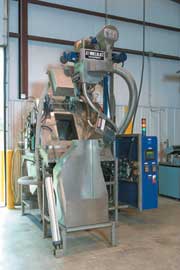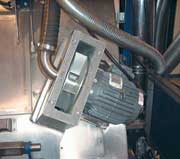E-Archive
Articles
in Vol. 4 - March Issue - Year 2003
New State-of-the-Art Cryogenic Deflashing Machine


Figure 1

Figure 2

Figure 3

Figure 4

Figure 5

Figure 6

Figure 7
The Jet Wheelblast Division of B&U Corporation located in Adrian Michigan, has developed a maximum efficiency, totally self-contained cryogenic machine to deflash rubber, and plastic moulded parts with a minimum of cycle time and operational cost. Under development for two years, the CMT-3 Multi-Tumbler has been designed to incorporate JetWheel's 30 years of experience as a leader in conventional dry and wet deflashing and deburring technology.
The American company has earned a worldwide reputation for innovative design features that increase productivity and reduce maintenance. It incorporates this experience in the new CMT-3 with such features as its impeller/control cage- adjustable pattern media wheel and its highly efficient patented pyramidal tumbling barrel (figure 1 & 2).
„Cryogenic processing has been in practice for over fifty years but very little progress has been made over the years to improve efficiency. After studying the cryogenic deflashing market, we saw many opportunities to substantially improve this process“ stated Udo Kuehn, President of B&U Corporation. „Many current production lines consist of pieced together components that are extremely inefficient and require constant maintenance,“ he continued.
All molded rubber and plastic parts experience flash or excess material in the area where the mold sections part. This flash increases as the mold wears from continued production, making it necessary to incorporate a deflashing process to bring the part into tolerance. Conventional deflashing and deburring machines are very effective on hard parts, but do not apply to soft or flexible rubber or plastic parts. Traditionally, these parts are cryogenically frozen prior to or during the deflashing process. The design of these cryogenic machines is very critical to the economic feasibility of the process. Three critical factors to consider include temperature retention through proper insulation, 100% seal efficiency at all openings and near zero moisture introduction from outside air during the load and unload process. „If you see frost or ice covering the outside surfaces of these machines, the chances of loosing profit from the production of these parts is very high (figure 3). In addition, moisture will cause parts to freeze together, and if media is used, it will cake up and require constant maintenance and longer cycle times.
„Recent studies have shown that the cost of liquid nitrogen can be reduced by as much as two-thirds with a highly efficient production system“, according to Kuehn.
The American manufacturer is recognized throughout many industries as a leader in innovation and for its uncompromising construction features. Its numerous patents have increased productivity in the wide variety of machines that it manufactures. Its line of dry blasting barrel machines range in capacity from 2 to 34 cubic feet. These incorporate a unique pyramidal barrel with contoured side ridges that move the parts in two directions for maximum blast exposure and minimum cycle times. This design is incorporated in the CMT-3 cryogenic multi-tumbler, which has a true three cubic foot capacity (5184 cu. in. capacity).
The CMT-3, unlike other cryogenic deflashing designs, is a totally closed, insulated and unified system that deflashes, separates removed material, and screens media and fines. Its all stainless steel construction features an insulated 5-inch double wall cabinet and quick acting load and unload designs to minimise temperature loss. All other components are also insulated. An automatic skip loader delivers the parts to the barrel and an automatic unload slide door unloads the parts quickly and safely. Both operations can be done in 20 seconds or less with very low internal temperature loss. This fast load-unload process greatly reduces the amount of moisture-laden air from entering the blast chamber which causes excessive ice build-up on the media, parts, and drum screen separator. An optional vibratory carry away conveyor avoids operator contact with the cryogenically frozen parts to prevent freeze burn.
The CMT-3 is engineered to provide total flexibility for control of speeds and temperature. This insures that optimum deflashing conditions are possible for the minimum use of energy and cycle times. Barrel rotation and wheel rotation are speed variable to accommodate a wide variety of parts and materials. Drive motors are located outside of the cabinet. The insulated blast wheel is direct drive, eliminating externally mounted bearings that can also negatively be affected by low temperatures.
The Deflashing Process
Media is blasted into the blast cabinet using the JWL-401 Jet Wheel that incorporates superior blast wheel design technology. Insulation protects the blast wheel‘s bearings from the effects of low temperature (figure 1 & 2). During blasting, the parts are tumbled in the barrel drum using a patented Pyramidal barrel design that tumbles the parts in two directions at the same time, for more efficient and faster cycle times Figure 3).
As flash is blasted off the parts, the spent media and flash are evacuated through a blower system that moves the material to the overhead cyclone, eliminating the troublesome screw conveyor to move the material quickly. The vertical conveyor pipe is double wall insulated to maintain temperature (figure 4 & 5).
A new patent pending media/flash separator incorporates a multitude of new features. The purpose of this new invention is to keep the media and flash in a frozen state to eliminate wetting and caking of the flash and fines. A horizontal cyclone receives the media and flash milliseconds after it has been thrown. Coarse media and fines are separated via cyclonic action from the conveying gas and are fed to the drum screen (figure 4).
The media and flash are tumbled in the drum screen, which allows the media and fines to fall through the holes, while the coarse flash is discharged out its end. The media fines are funnelled into a curtain where metered nitrogen gas is pushed through the curtain taking the fines with it into the waste barrel. The gas stream keeps the fines frozen and eliminates the introduction of humidity. At the same time, media is accumulated within the storage hopper below. The storage hopper is equipped with a pneumatically operated abrasive feed valve, which feeds the Jet Wheel. The separation intensity and fine sizing is adjustable for optimum performance. This totally closed loop system avoids outside air contamination. The introduction of moisture into the system is a problem as the flashing material warms and becomes soft, causing plugging of filter screens (figure 6). The new system can be accommodated in a minimum of floor space compared to current systems.
The total process is controlled by a single operator using a key pad command center for all functions while never coming into contact with frozen media, parts, or flash material. The control panel controls cabinet temperature, barrel rpm, wheel rpm, cycle time, as well as loading and unloading of parts. MMI is capable of part no/part process control (process recipes-figure 7).
Jet Wheelblast is a single source supplier of dry and wet blasting equipment and systems for a variety of companies requiring pre-treatment and cleaning systems. They offer a wide variety of machine designs and provide full service backup and 24 hour replacement part accommodations.
„Our company has made a commitment to offer the benefits of our extensive deflashing expertise to the cryogenic deflashing process“ concluded Kuehn.
For Information:
Jet Wheelblast Equipment
401 Miles Drive
Adrian, MI 49221, USA
Tel. +1.517.263 0502
Fax:+1.517.263 0038
E-mail: sales@bucorp.net




























